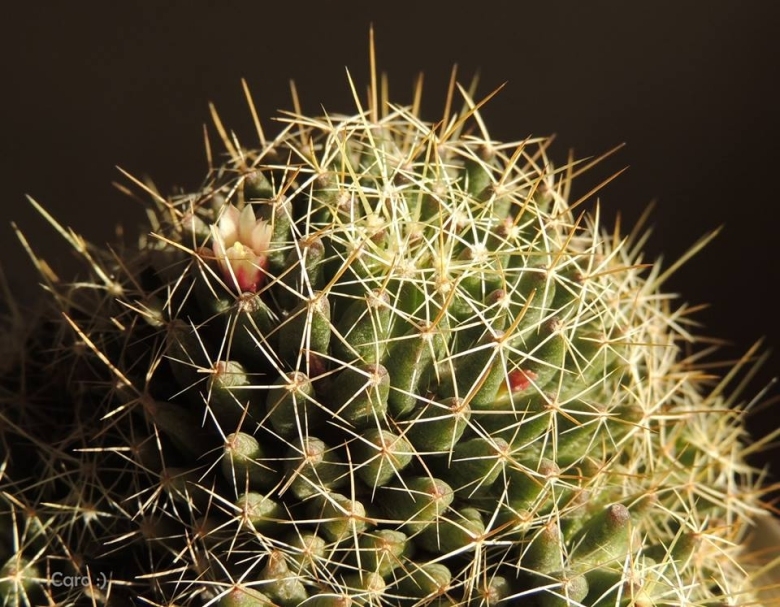
Mammillaria decipiens Photo by: Carolina González
Origin and Habitat: San Luis Potosi, Guanajuato and Queretaro, Mexico. Eastern Mexico
Altitude: 1550 to 2150 metres above sea level.
Habitat: This species occurs in relatively low densities across its range, but is fairly common in appropriate habitat. It lives in canyons and on rocky hills, generally in volcanic soils. This species is often found in matorral under bushes in association with other plant species, including Opuntia microdasysSN|10936]]SN|15506]], Opuntia tunicataSN|28228]]SN|28228]], Opuntia leptocaulisSN|15506]]SN|10936]], Myrtillocactus geometrizansSN|8050]]SN|8050]], Ferocactus histrixSN|4300]]SN|4300]], Echinocereus cinerascensSN|7775]]SN|7775]], Mammillaria vagaspinaSN|9435]]SN|9435]], Jatropha spathulata, Coryphantha erectaSN|3941]]SN|3941]], Stenocereus dumortieriSN|7951]]SN|7942]], Stenocereus pruinosusSN|7942]]SN|7951]], Thelocactus hexaedrophorusSN|10830]]SN|10830]], Yucca filifera, Agave salmianaSN|23013]]SN|27883]], and Agave lechuguillaSN|27883]]SN|23013]].
Synonyms:
See all synonyms of Mammillaria decipiens
Common Names include:
ENGLISH: Bird's-nest pincushion
UKRAINIAN (Українська): Мамілярія деципіенз, Мамілярія оманлива
Description: Mammillaria decipiensSN|9068]]SN|9068]] (a.k.a. Bird's Nest Mammillaria) is a low growing, prominently ‘nippled' cactus species, with long, bristly spines that cross each other forming a sort of bird's nest look (hence its common name).
Habit: Usually cespitose, sprouting unevenly from the base and sides, often forming large mounds.
Root: Very large, tuberose.
Stem: Individual stems, globose to club shaped, rounded at the top, 6 to10 cm high, 4-7(-10) cm in diameter, grass green to deep green.
Tubercles: Soft, cylindrical to obtuse, 10-22 mm long 5-7 mm in diameter, their axils bearing or sparse wool and 3 fine bristles each. Without latex.
Radial spines: 5 to 11, spreading, 7-15 mm long or as long as 30 mm, bristle-like, straight, slender, white to brownish-white, sometimes yellowish with brown tips, puberulent when young.
Central spines: 1-2 rarely none, much longer than the radials, 10-27 mm long, straight, erect or ascending, slender, needle-like, bristly, dark brown.
Flowers: 15-18 mm, long, 10 mm across, broadly funnel-shaped, slightly scented; inner perianth-segments nearly white or faintly tinged with pink, acute; filaments white to pinkish; stigma-lobes 4, white or pinkish, slender, filiform. Flower-buds pinkish, acute.
Fruit: Cylindrical, reddish green.
Seeds: Light brown.
Subspecies, varieties, forms and cultivars of plants belonging to the Mammillaria decipiens group
Bibliography: Major references and further lectures
1) Robert T. Craig “The Mammillaria handbook: with descriptions, illustrations, and key to the species of the genus Mammillaria of the Cactaceae” E P Publishing, 1945
2) John Pilbeam “Mammillaria The Cactus File Handbook” Cirio Pub. Services, 01/Dec/1999
3) Edward Anderson “The Cactus family” Timber Press, Incorporated, 2001
4) James Cullen, Sabina G. Knees, H. Suzanne Cubey "The European Garden Flora Flowering Plants: A Manual for the Identification of Plants Cultivated in Europe, Both Out-of-Doors and Under Glass" Cambridge University Press, 11/Aug/2011
5) David R Hunt; Nigel P Taylor; Graham Charles; International Cactaceae Systematics Group. "The New Cactus Lexicon" dh books, 2006
6) Sánchez , E., Guadalupe Martínez, J. & Bárcenas Luna, R. 2013. Mammillaria decipiens. In: IUCN 2013. IUCN Red List of Threatened Species. Version 2013.1. <www.iucnredlist.org>. Downloaded on 21 July 2013.
7) N. L. Britton, J. N. Rose “The Cactaceae. Descriptions and Illustrations of Plants of the Cactus Family.” Volume 4, The Carnegie Institution of Washington, Washington 1923
8) John Borg “Cacti: a gardener's handbook for their identification and cultivation” Blandford P., 1970
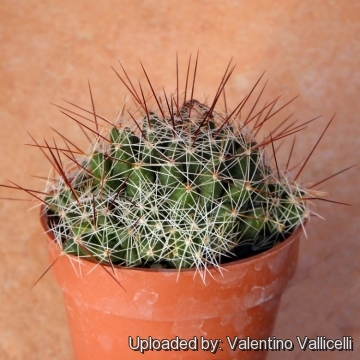 Mammillaria decipiens Photo by: Valentino Vallicelli
Mammillaria decipiens Photo by: Valentino Vallicelli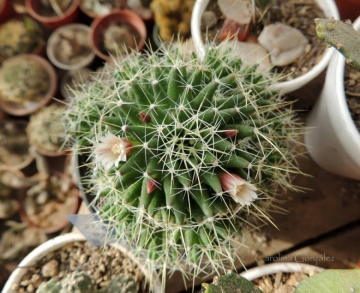 Mammillaria decipiens Photo by: Carolina González
Mammillaria decipiens Photo by: Carolina González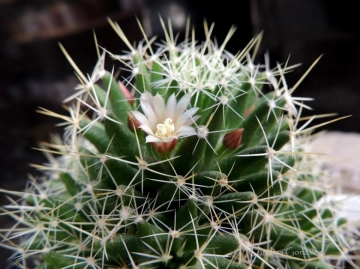 Mammillaria decipiens Photo by: Carolina González
Mammillaria decipiens Photo by: Carolina González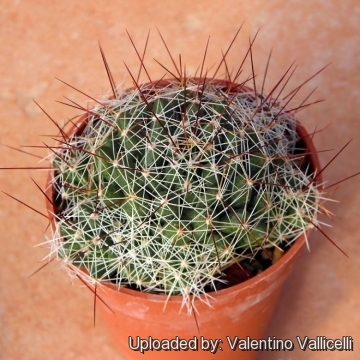 Mammillaria decipiens Photo by: Valentino Vallicelli
Mammillaria decipiens Photo by: Valentino VallicelliCultivation and Propagation: Mammillaria decipiensSN|9068]]SN|9068]] is a freely clustering species that reproduces easily by cutting. It is a great starter plant for the cactus grower, that readily builds up into a dense cluster of stems. Does better than most species in lower levels of light, but still prefers bright light or morning sun.
Growth rate: Plants will offset readily, and dense clumps can be produced in a very few years.
Soils: It likes very porous mineral substratum and avoid the use of peat or other humus sources in the potting mixture.
Repotting: Repotting every 2-3 years, , or sooner if the roots get crowded. . As it is prone to rot under-pot in a smaller container filled with very porous compost. Use pot with good drainage.
Watering: Water regularly in summer, but do not overwater (very wet-sensitively, especially in light of its succulent root system). Its roots are easily lost in pots that stay damp for any length of time. Keep dry with ample airflow in winter. In the rest period no high atmospheric humidity!! Care must be taken with watering as they tends to become swollen and untidy in growth habit if given too much water and shade.
Fertilization: During the growing season enrich the soil using a fertilizer rich in potassium and phosphorous, but poor in nitrogen, because this chemical element doesn’t help the development of succulent plants, making them too soft and full of water.
Hardiness: It is quite frost resistant if kept dry, hardy as low as -5° C (some reports give it hardy to -7°C). However some warmth throughout the year will increase the grower's success (minimum 5° to 8°C during rest season). A resting period in winter and strong light are necessary so that it can flower properly.
Exposition: Outside filtered sunlight or afternoon shade, inside it needs bright light, and some direct sun. Subject to sunburn if exposed to direct sun for too long. Does better than most species in lower levels of light, but still prefers bright light or morning sun.
Uses: It is an excellent plant for container growing. It always looks good and stays small. It look fine in a cold greenhouse and frame.
Pests & diseases: It may be attractive to a variety of insects, but plants in good condition should be nearly pest-free, particularly if they are grown in a mineral potting-mix, with good exposure and ventilation. Nonetheless, there are several pests to watch for:
- Red spiders: Sensitive to red spider mite. Overhead watering is helpful in controlling mites.
- Mealy bugs: Occasionally mealy bugs they develop aerial into the new growth among the wool with disfiguring results, but the worst types develop underground on the roots and are invisible except by their effects.
- Scales: Scales are rarely a problem.
- Rot: Rot it is only a minor problem with cacti if the plants are watered and “aired” correctly. If they are not, fungicides won't help all that much.
Propagation: Direct sow after last frost or (usually) or division . Seeds germinate in 7-14 days at 21-27° C in spring, remove the glass cover gradually as the plants develops and keep ventilated, no full sun for young plants! The seedlings should not be disturbed until they are well rooted, after which they can be planted separately in small pots. Cuttings: wait until the offsets that appear at the base of old clustered specimens are 1/3 the size of the parent and then detach and plant. Cuttings will take root in a minimum temperature of 20° C (but better in hot weather). Cuttings of healthy shoots can be taken in the spring and summer. Cut the stem with a sharp, sterile knife, leave the cutting in a warm, dry place for a week or weeks (depending on how thick the cutting is) until a callus forms over the wound. Once the callus forms, the cutting may be inserted in a container filled with firmed cactus potting mix topped with a surface layer of coarse grit. They should be placed in the coarse grit only; this prevents the cut end from becoming too wet and allows the roots to penetrate the rich compost underneath. The cuttings should root in 2 to 6 weeks.














